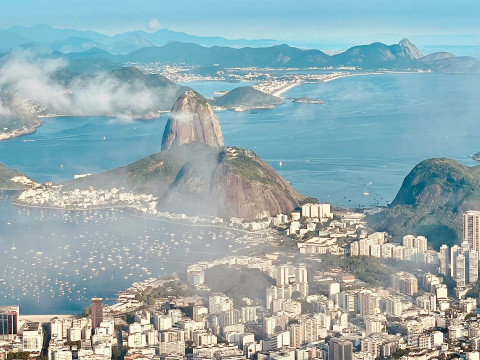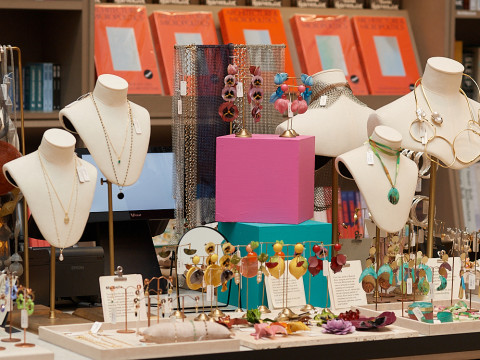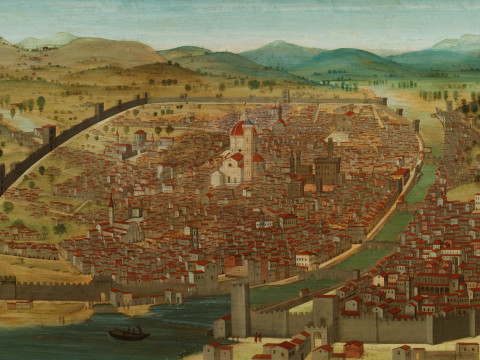
Making Space
By CF Prior
Published on 15 March 2024
Meet the artists and teachers behind Making Space, a new project at the RA that provides creative and professional support to eight learning-disabled and neurodivergent artists.
Around a table, in a large, light-filled room at the Royal Academy, a few people are looping shining black ink across kraft paper. Others are gathered around urns of tea and coffee, filling their cups and offering out mince pies. Some are still rolling in, trying to shake off the journey through the West End at Christmas. Jemima Senior, Communities Programmer, moves from person to person, welcoming everyone, catching up and making introductions. One of the artists, Trevor Small, has brought with him framed paintings featuring his trademark cowboys riding horseback – gifts for each of the facilitators. The mood here is relaxed but celebratory. From a speaker in the corner, the Ronettes are quietly enjoying a sleigh ride.
Today marks the halfway point of the RA pilot project Making Space – a free, year-long artist development programme for learning disabled and neurodivergent artists. As the group’s last meeting of 2023, it’s a chance to look back on what they’ve enjoyed, what they haven’t, how their practices have changed, and to look at the year ahead.

Over the previous six months, this group of eight artists, accompanied by support workers and a team of artist-educators, have produced sound art, collaborated on sculpture, transformed the Clore Learning Centre into a light installation and created a 3D non-verbal artist statement. They’ve visited the Academy’s library and archives, the RA Schools studios and exhibitions on nearby Cork Street. As if to honour the RA’s founding President, Joshua Reynolds, who stressed to all aspiring artists the importance of studying the art of ‘the great masters’, they’ve made studies of works in the RA Collection Gallery. But it’s perhaps their exposure to one another’s artwork that has produced the most change. Cecilia Caulder (pictured above), better known as C.C, makes intricate paintings of ponds and woodland understories often using a vibrant, contrasting palette reminiscent of Alex Katz’s sundrenched Lincolnville flower paintings. After a workshop led by fellow participant, photographer and printmaker Josh Brown, C.C tried the multilayering stencilling technique she’d learnt from him. This morning, she presented her latest work, a pastel-hued, serene vase of tulips (below).
It took a while to get to this point; for the group and programme to cohere. "As with any group," says Senior, who runs Making Space, "it can take a long time to build up a rapport." Partly that’s because some participants are likely to be absent due to ill health and partly because group work is inherently anxiety inducing. Before the first session, C.C felt uneasy about the prospect of meeting and working closely with other artists; another participant, Chris Harman, says he shared her trepidation, having rarely made art collaboratively. And as each artist has a preferred medium – including embroidery and collage, as well as painting, sculpture and printmaking – devising a programme to meet all of the artists’ aspirations and encourage experimentation had taken time.

Most of the cohort are already members of supported studios, creative spaces designed for neurodivergent and learning disabled artists, so the question of what the RA could offer that would differ from, but complement, those organisations was a crucial consideration. "We decided we could afford to be playful, not too formal, not too professional," explains Senior. Molly Bretton, Head of Learning, agrees: "The programme allows artists to try out new ways of working. It acts as a testing ground and a catalyst for new projects." After consulting widely in the sector, they focused the programme on artists in the early stages of their practice who would benefit from the RA’s resources and professional network, but for whom traditional routes of art education wouldn’t be accessible.
The team was inundated with applications, perhaps because Making Space is unusual in an arts institution, as it’s a long-term programme and offers both creative and professional development. "It speaks to the barriers to art education that so many people face," says Bretton. "There is a lack of inclusive learning opportunities elsewhere."

At the workshop I meet artist Anna Farley, who received her autism diagnosis as an undergraduate in Fine Art. She describes how her university failed to hear and accommodate her needs, and how she was subjected to harmful stereotyping, including infantilising comments about her capacity to negotiate the critical writing component of her degree. She graduated with a good grade and a sour taste in her mouth. She considered applying to the RA Schools postgraduate programme but was worried about the impact of full-time study on her mental health, her family and her social support system.
Farley let the idea of future, formal arts education simmer and in 2017 founded Autography with Photofusion – a project using photography as a way for autistic adults to explore their identity – and worked producing art, workshops, training and visual guides for institutions like Tate and the British Film Institute. She applied to Making Space when it was advertised in 2023. But with such experience, instead of a place on the programme, she was offered a role as an artist-educator.
If we want an art world that reflects the variety of human experience, we can’t have one that excludes learning disabled and neurodivergent artists
Molly Bretton, Head of Learning
A vexatious relationship to formal arts education is shared by other artists in and around Making Space.
After a tour of his studio, featuring a set rigged up for stop-motion animation and striking paintings depicting Congolese domestic scenes, RA Schools student Djofray Makumbu shows the artists his digital video. The animated interviews with his friends, and young people with disabilities from Eastbury Community School in Barking, explore masking – the attempts and strategies neurodiverse people use to hide their disability.
Makumbu’s own experience of school, as someone learning disabled, was of being put to one side. He describes being told repeatedly that he wasn’t trying hard enough and, later, by a careers counsellor, that his ambition to become an artist was unrealistic. But he already was an artist, and credited art with helping him stay sane. One teacher, Mr Julian, recognised this and encouraged him to apply to art school, at Goldsmiths in London, where "everyone helped me at every stage". Given that 15.9% of English school pupils in 2021 had special educational needs or learning disabilities, it’s hard not to wonder what happens to would-be artists lacking someone like Mr Julian’s support. Bretton thinks about this a lot when considering inclusion in all aspects of the learning programme, from early years to families, and schools through to adulthood. "If we want an art world that reflects the variety of human experience, we can’t have one that excludes learning disabled and neurodivergent artists," she says.

In his talk, Makumbu is at pains to stress that he would not have made it to the RA Schools on his own. This isn’t necessarily a function of his disability, but rather a function of being an artist. Some contemporary artists were beneficiaries of cheaper rents and lower art school fees. Others come from families able to provide financial support for arts education. Still others benefit from supported studios or working with artist-educators – like Anna, Georgia Akbar and Helen Rousseau, from Making Space – who can offer advice and adapt their practices to the groups’ needs and hopes. This support provides a framework for artists to ask questions, work with new materials and make mistakes, communicate their ideas and grow in confidence.
Working with new people and different styles has given the artists newfound self-assurance. Since starting with Making Space, as well as delivering the printmaking workshop that inspired C.C’s dreamy still life, Josh has presented his work at the Bound Art Book Fair in Manchester. C.C, who makes a new sketchbook page after each session, feels more relaxed about her artistic decisions, less pressure to make the ‘right choice’. Chris, Trevor and Richard feel emboldened by the way that those in the group look out for each other. "We make different decisions when we make them together," says Chris.
CF Prior is a writer, researcher and the RA’s Learning Editor.
Learn more about Making Space, and applications for the 2024/25 programme.
If you are interested in supporting Making Space and the RA’s Learning programmes, please email philanthropy@royalacademy.org.uk.

Enjoyed this article? Join the club
As well as free entry to all of our exhibitions, Friends of the RA enjoy one of Britain’s most respected art magazines, delivered directly to your door. Why not join the club?
Related articles

Five Brazilian cultural icons from the 20th century
28 February 2025

A love letter to the gallery gift shop
18 November 2024

Painting the town: Florence in 1504
15 November 2024